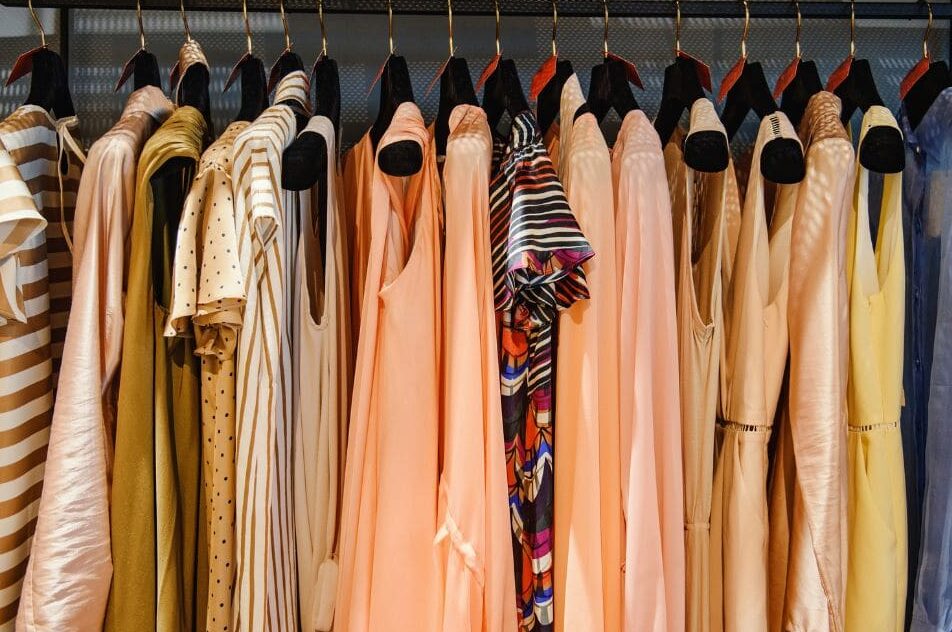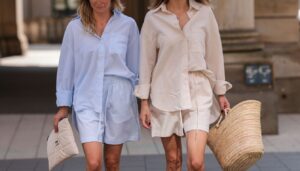
The study of the history of clothing and textiles traces the development, use, and availability of clothing and textiles over human history. Clothing and textiles reflect the materials and technologies available in different civilizations at different times. The variety and distribution of clothing and textiles within a society reveal social customs and culture.
For centuries clothes have been used, not just for practicality, but as a way of projecting an image and appearance to the rest of the world. This is one of fashion’s very strengths, the manner in which it acts as a form of sociological armour for its wearer. Teunissen describes this ability “to communicate a personal and social identity” as “the most important aspect of fashion, for centuries.” Designers such as Adele Varcoe (one of a number of those in the exhibition currently undertaking a PhD) are focusing on these sociological myths of clothing, with Varcoe directly referencing the story of the emperor’s new clothes fairytale and its message of the powerful projections of fashion. By creating several performances only body stockings are worn (including a reconstruction of a 1920s Chanel show, without the clothes) Varcoe questions “what is concrete and material and what is just a culture and a belief in the visual elements.” Meanwhile, Forrest Jessee is taking fashion back to its most basic and exploring how clothing can be used practically and how new technologies can be manipulated to recreate comfort and protection. Jesse’s Sleep Suit is a form of “architecture connecting to something you can wear,” a comforting cocoon that is simple but maintains an avant-garde appeal.
Ancient Times In ancient times, clothing was used primarily for practicality, protection, and modesty. The earliest clothing was made from animal hides and plant fibers and was often draped or wrapped around the body. During the Bronze Age, textile production began, and clothing became more intricate and decorated. In Ancient Greece, clothing was highly symbolic, with certain colors and styles reserved for certain classes of people.
Trends in fashion and beauty throughout history, including notable designers and iconic styles.
In conclusion, fashion has evolved significantly throughout history, with each era reflecting the social, cultural, and technological changes of its time. From practicality and modesty to extravagance and self-expression, fashion has served as a reflection of human society and culture, and will continue to do so for generations to come.
![]()
3.6 Present In today’s era, people dress based on many different influences, choices and priorities. Some of the fashion trends are even based on looks from past decades, mentioned above. Trends change all the time, but more influenced by many TV shows or seeing what many celebrities wear. Unless you like it the particular fashion, just wear whatever you feel like today!.
Fashion trends are influenced by several factors, including cinema, celebrities, climate, creative explorations, innovations, designs, political, economic, social, and technological. Examining these factors is called a PEST analysis. Fashion forecasters can use this information to help determine the growth or decline of a particular trend.
Current and future trends in fashion, including sustainability and ethical practices.
Sustainable Fashion and Textiles: Design Journeys brings together for the first time information about lifecycle sustainability impacts of fashion and textiles, practical alternatives, design concepts and social innovation. It challenges existing ideas about the scope and potential of sustainability issues in fashion and textiles, and sets out a more pluralistic, engaging and forward-looking picture, drawing on ideas of systems thinking, human needs, local products, slow fashion and participatory design, as well as knowledge of materials. The book not only defines the field, it also challenges it, and uses design ideas to help shape more sustainable products and promote social change. Arranged in two sections, the first four chapters represent key stages of the lifecycle: material cultivation/extraction, production, use and disposal. The remaining four chapters explore design approaches for altering the scale and nature of consumption, including service design, localism, speed and user involvement. While each of these chapters is complete in and of itself, their real value comes from what they represent together: innovative ways of thinking about textiles and garments based on sustainability values and an interconnected approach to design.

After analyzing the main fashion trends from 2016 to the present, it is possible to highlight those destined to persist in the coming years: the adoption of sustainability practices among fashion players, attention to the sustainability of the entire value chain, continuous improvement of customer service provided by digital platforms, increased automation of production processes. In recent years, more and more attention has been paid to the issues of environmental sustainability by Governments, consumers, and companies.
The textile sector has been the subject of heavy criticism connected to its environmental impacts and human health arising from residues of substances on products and production processes associated with it. Attention to the ecological dimension is expressed in reducing the waste of natural resources, reducing production costs, reducing global warming, and paying attention to the consequences of overpopulation, containing the toxicity of certain industrial products, and reducing air and water pollution. According to the analyses carried out, a positive trend clearly emerged for the future; the answers provided by respondents represent hope for an increase in the ethical approaches to business and in the adoption of sustainable strategies and practices in the fashion industry.
The results are strictly consistent with the literature related to the topic analyzed in the paper; in fact, considering Generation Z as a benchmark (due to the number of respondents which composed the sample), it was analyzed how, based on a gender classification, the answers related to these topics present differences. The sample clearly showed a preponderance of the role assigned to sustainability in fashion by female respondents.
Much more interesting, and partially divergent from the literature, is the non-difference within the sample between Generation Z and people older than 26 years old. This result could be determined by the composition of the sample (see the paragraph “Limitations of the Research and Future Developments”) even if, for the central limit theorem, a number equal to 188 is largely sufficient to approximate the data to a normal distribution. Considering the role of the circular economy, fashion companies can implement a circular policy by choosing the most suitable business model. It is important not to forget the importance of the design of fashion product that can be disassembled, the conception of the product as a service, the use of available resources, the recovery, reuse, and extension of the product life cycle. According to the respondents, as previously discussed, the decision-making process to discard a dress is mainly based on concrete issues and personal tastes, and they consider fashion as a less important element.
Considering the aspect of solidarity, it emerged that over 1000 respondents (which represented more than 80% of the sample) were inclined to leave their used clothes to voluntary associations/churches. This is a favorable point for the development, in solidarity, of this kind of economy. Finally, it seems that the purchase of used clothes is not interesting for the respondents; this result was certainly influenced by the economic condition and Italian cultural background, which is very different from other countries such as India or Vietnam, where this practice is well diffused.
In the past year, the focus around sustainable fashion has continued to grow, as industry leaders made pledges to sustainability at COP26, accelerated material innovation and began to explore circularity. Most importantly, a growing realisation emerged that climate change is as much about equity as it is about carbon footprints.






